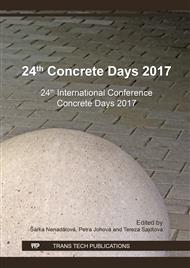p.135
p.141
p.147
p.154
p.160
p.166
p.172
p.178
p.185
Long-Term Monitoring of Concrete Building Structure
Abstract:
Long-term deformations of the concrete are important for determination of behavior of concrete structures. For prediction of the long-term deformations rheological models are used. The models are usually derived from measurements on laboratory specimens. There are only few measurements performed on real structures. The objective of the realized experimental program is to compare predicted values of strains and strains measured on a real structure. Vibrating wire strain gauges have been installed in two columns in underground floors of eight-storey office building. Target of this paper is evaluation of measurement from the initial period (7 to 8 months). Measured values have been compared with results of first calculations and with values measured on laboratory specimens placed at the construction site.
Info:
Periodical:
Pages:
160-165
Citation:
Online since:
February 2018
Authors:
Keywords:
Price:
Сopyright:
© 2018 Trans Tech Publications Ltd. All Rights Reserved
Share:
Citation:


